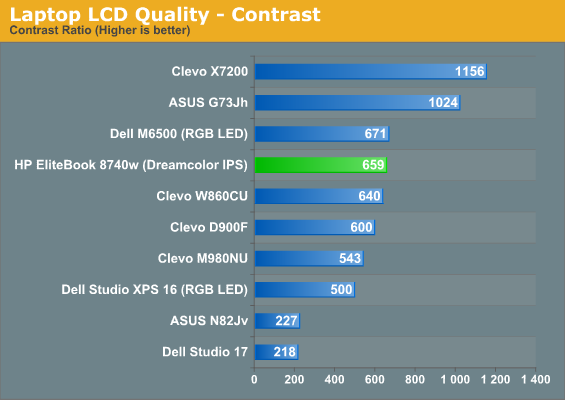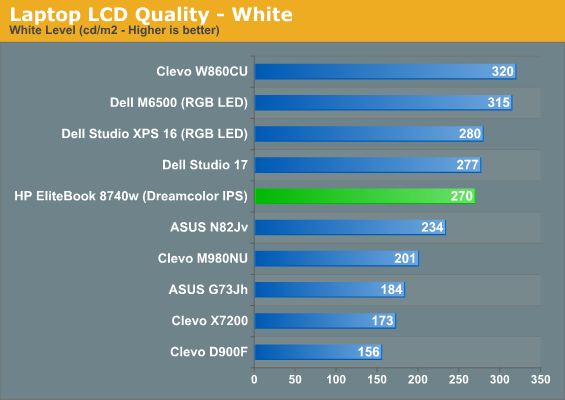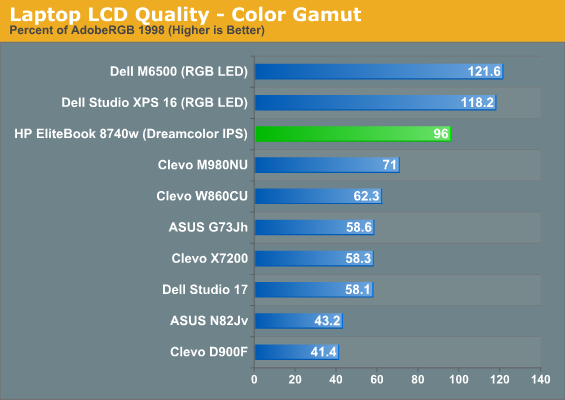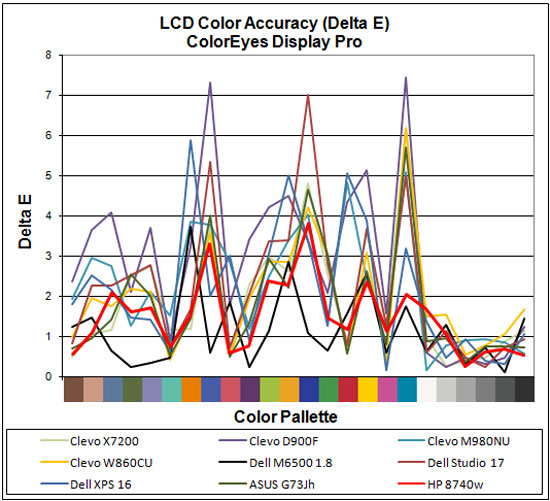HP EliteBook 8740w: IPS on the Go
by Dustin Sklavos on December 8, 2010 3:10 AM EST- Posted in
- Laptops
- IT Computing
- Intel
- HP
- EliteBook
- Mobile Workstation
- Quadro
- NVIDIA
The $550 DreamColor IPS Upgrade
And here we get to the tough part. HP touts the DreamColor matte IPS panel option in their EliteBook 8740w with good reason: it's an IPS panel in a market where anything other than a TN is exceedingly rare. The problem is that it does command a premium, and a massive one: $550 ($570 with the webcam). Dell doesn't charge anywhere near as much for their screen upgrades, so we really want to know if we're going to get what we pay for with the DreamColor.







You asked for an IPS panel, and you got one. The DreamColor produces incredibly accurate color that basically covers the AdobeRGB 1998 color space. Contrast is excellent and of course you get fantastic viewing angles as well. Black and white levels are both quite nice. Overall it's a great-looking panel.
That said, it still has trouble surpassing the Dell notebooks, particularly the Precision M6500, which boasts both superior color gamut and color accuracy by our measure. It gets worse, too: that upgrade to the M6500 is about $200 cheaper...but then it's not IPS. Realistically, few people will need the higher Dell Gamut, but you're still looking at almost twice the upgrade cost to get IPS in place of TN, and we'd say the M6500 RGB LED panel is already priced quite high. $600 can get you a pretty awesome 24" desktop LCD, but a 17" laptop panel with similar characteristics still costs more.
Subjectively it must be said that while the DreamColor panel on the EliteBook 8740w is very attractive and miles away from what we're used to seeing, even after calibration colors can feel oversaturated. 100% Adobe RGB gamut is good for those that need it, but for everyone else working in sRGB color space, that's the penalty. Yes, we're used to seeing dismal, washed out color when testing notebooks, but the 8740w's colors are still too bright at times—and it must be said, the 120% gamut of the M6500 is even worse in this respect. Though our measurements don't totally bear this out, there's definitely some black crush going on as well. I use a calibrated Dell 2709WFP on my desktop, a screen most agree has some issues with oversaturation, and it seems positively mild compared to how bright the colors on the 8740w's DreamColor can be.
Make no mistake, this is a fantastic panel; however, it may not be the game-changer we were looking for, especially not when the Precision M6500 is hanging around. $300 will go from standard LCD to high color gamut WUXGA, but you're still stuck with TN panels; the additional $250 will add the viewing angles that IPS provides. As mentioned in our recent look at an old ThinkPad T42, a good laptop display can be nigh on impossible to find, and HP provides one. It just so happens that the display costs as much as (or more than) a larger 24" LCD that could sit on your office desk.














63 Comments
View All Comments
erple2 - Friday, December 10, 2010 - link
That 1000 dollars more or less covers the upgrade from the FX3800M to the FX5000M. So I'd be willing to bet that's where the cost goes.Dug - Wednesday, December 8, 2010 - link
Many designers work at the office and at home. The 17" works well because its very hard to work on a 15" screen.The size isn't bad when you consider they are only transporting it from office to car and car to home.
Now if you are traveling everywhere such as on a plane, then you wouldn't be looking at one of these anyway.
I'm just glad Anantech is taking the time to review a wide variety of laptops and emphasizing screen quality. Hopefully product managers and marketing get off their high horse and realize that people don't want crap. A lot of us are willing to pay for quality. If laptop manufacturers would just look at what has been reviewed and look at all the plus and minuses, then make a notebook that is all pluses. It really isn't that hard. Apple really took charge on this (although not perfect), so I hope others follow.
kmmatney - Wednesday, December 8, 2010 - link
I'm an Engineer/Scientist/Programmer who works at home, and use a 17" Dell with an upgraded 1920 x 1200 panel, bought in early 2007. I remember having to fight hard to justify the extra $300 in screen and cpu upgrades, but they were well worth it. Our normal upgrade laptop cycle is 3 years, but with a T7200 Merom and a 1920 x 1200 "true life" display, I can hang onto my system for a while yet. Along with a recent SSD upgrade, my system is about as fast as anything I can buy new at the moment (until SandyBridge, I think).What kills me sometimes is the weight - it can really hurt your shoulder after carrying it a while. My computer case has wheels, so I use those whenever possible.
I fly a lot, so get free upgrades to economy plus on United. With the extra leg room, I can easily use my 17" laptop on the plane.
Belard - Wednesday, December 8, 2010 - link
With one our ThinkPad users, he has a dock that allows him to connect two 23" 1920x1080 screens. So he gets the portability of a 14" notebook with the power to drive two big monitors. Not bad for a $250 dock with DVI & Display Port connectors, which also has USB, Ethernet and recharges the notebook's battery.Burner.Tom - Wednesday, December 8, 2010 - link
Are u sure about only 1-year standard warranty, because as I know, all EliteBooks have 3 yeat standard warranty.SandmanWN - Wednesday, December 8, 2010 - link
Should be 3 years. Even the models below this, ProBooks, have 3 years.sheltem - Wednesday, December 8, 2010 - link
It's 3 years - 8740w ownerDorin Nicolaescu-Musteață - Wednesday, December 8, 2010 - link
"even after calibration colors can feel oversaturated. 100% Adobe RGB gamut is good for those that need it, but for everyone else working in sRGB color space, that's the penalty."Sorry guys, but that's just not true.
One has to use color-managed applications to judge if color is good or not. In a non-color-managed environment, a wide gamut display will have incorrect (oversaturated) colors, just like a low-gamut display (undesaturated).
Just curious, how do you judge whether the colors are oversaturated or not? What do you look at and with what software?
kmmatney - Wednesday, December 8, 2010 - link
The eyes are a pretty good judge at oversaturation.In my line of work, I have to often align X-ray beams for scientific equipment. I can use a high-sensitive, high-precision detector, or just use my eyes and a fluorescent screen to maximize the X-ray beam intensity. Although I always double-check things using the detector, I've found that my eyes can detect tiny changes in the green glow from the fluorescent screen, and always get the sensitive alignments spot on. We are talking about very small changes - its pretty amazing what the eyes can detect.
JarredWalton - Wednesday, December 8, 2010 - link
I'm curious... what exactly is "not true" about the above statement? (This is directed at Dorin.) Good for those that need it is another way of saying "good in color managed applications", which is why we go on to state that everyone working in sRGB isn't going to like it as much.